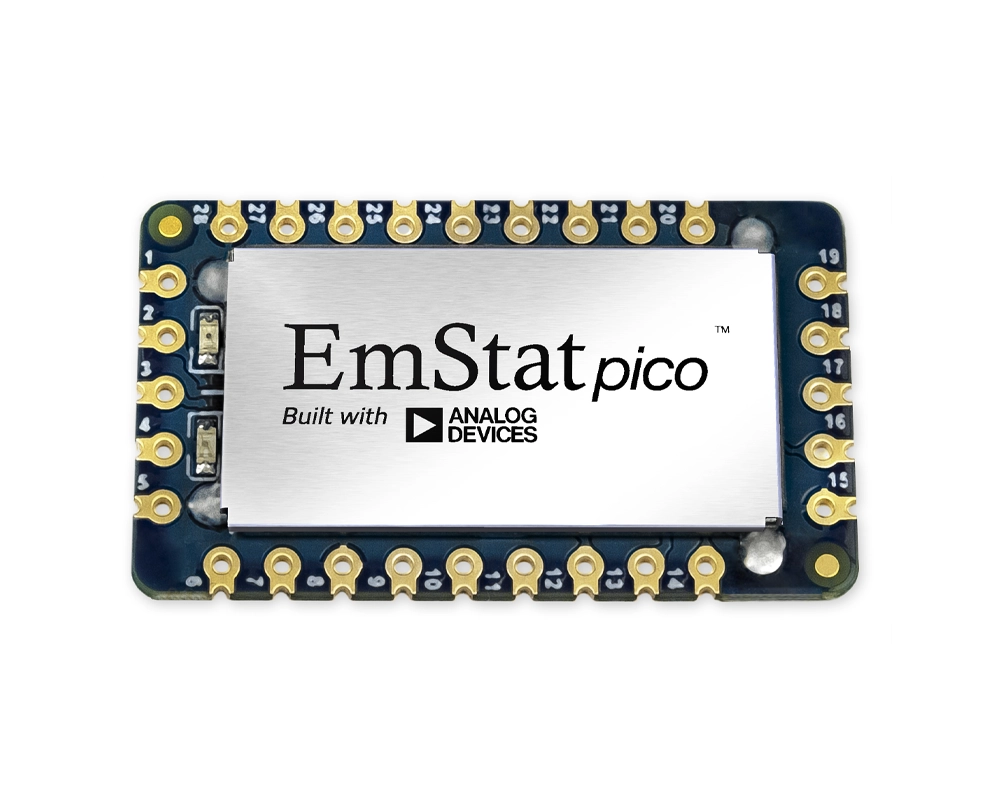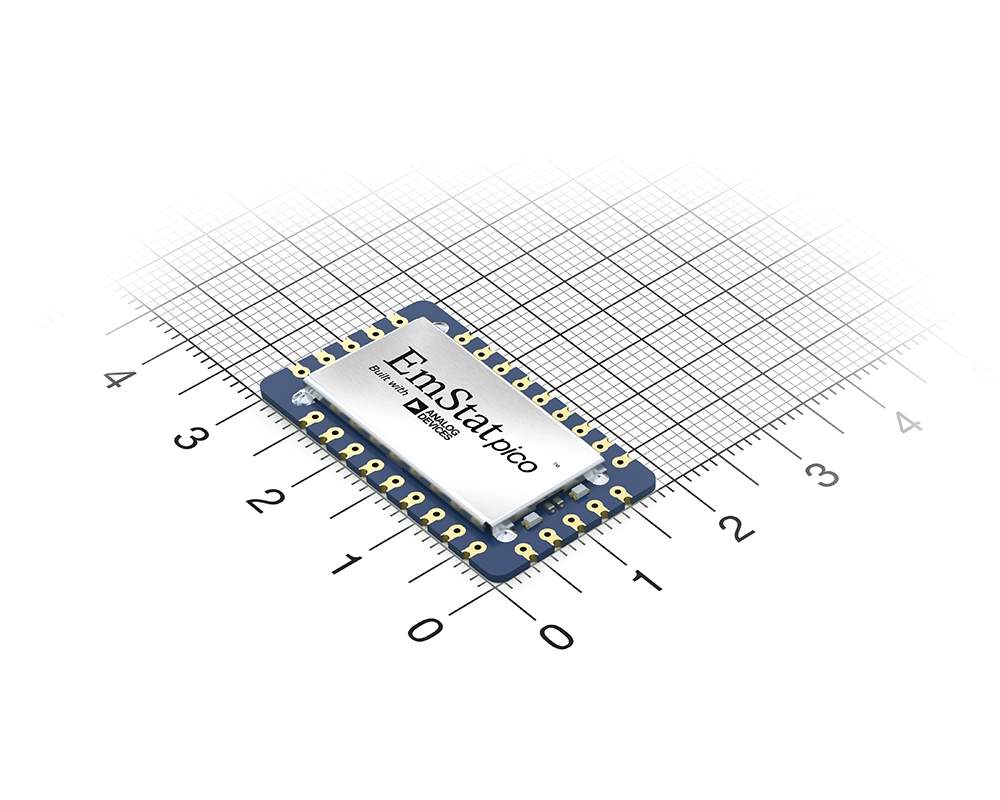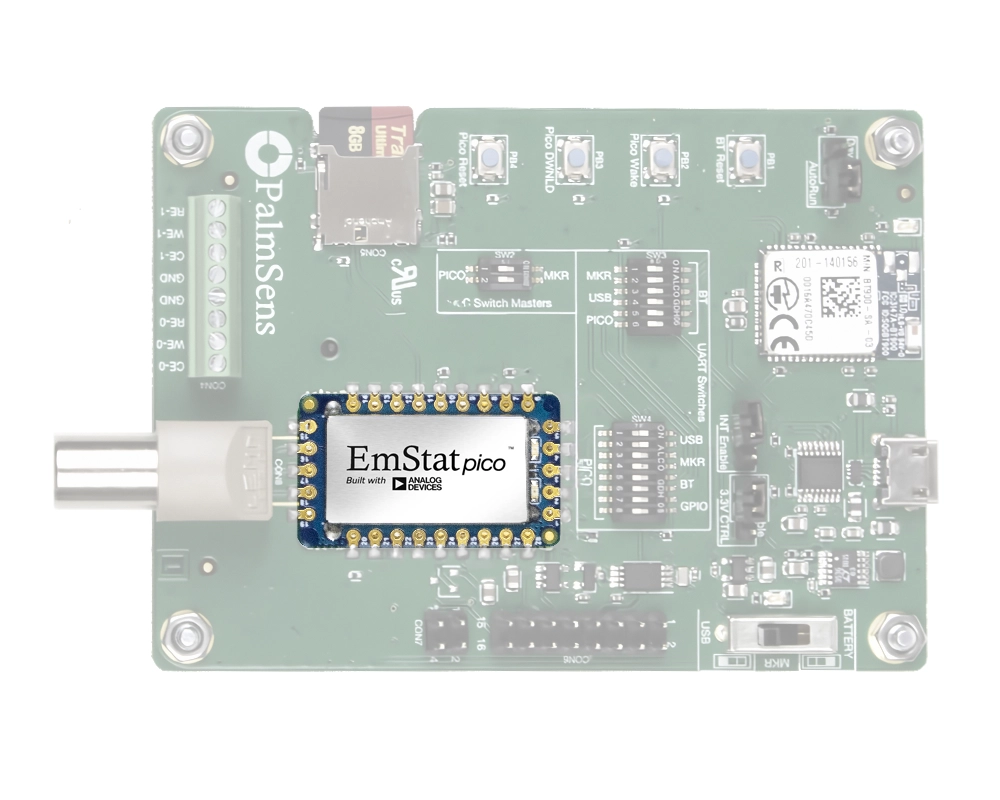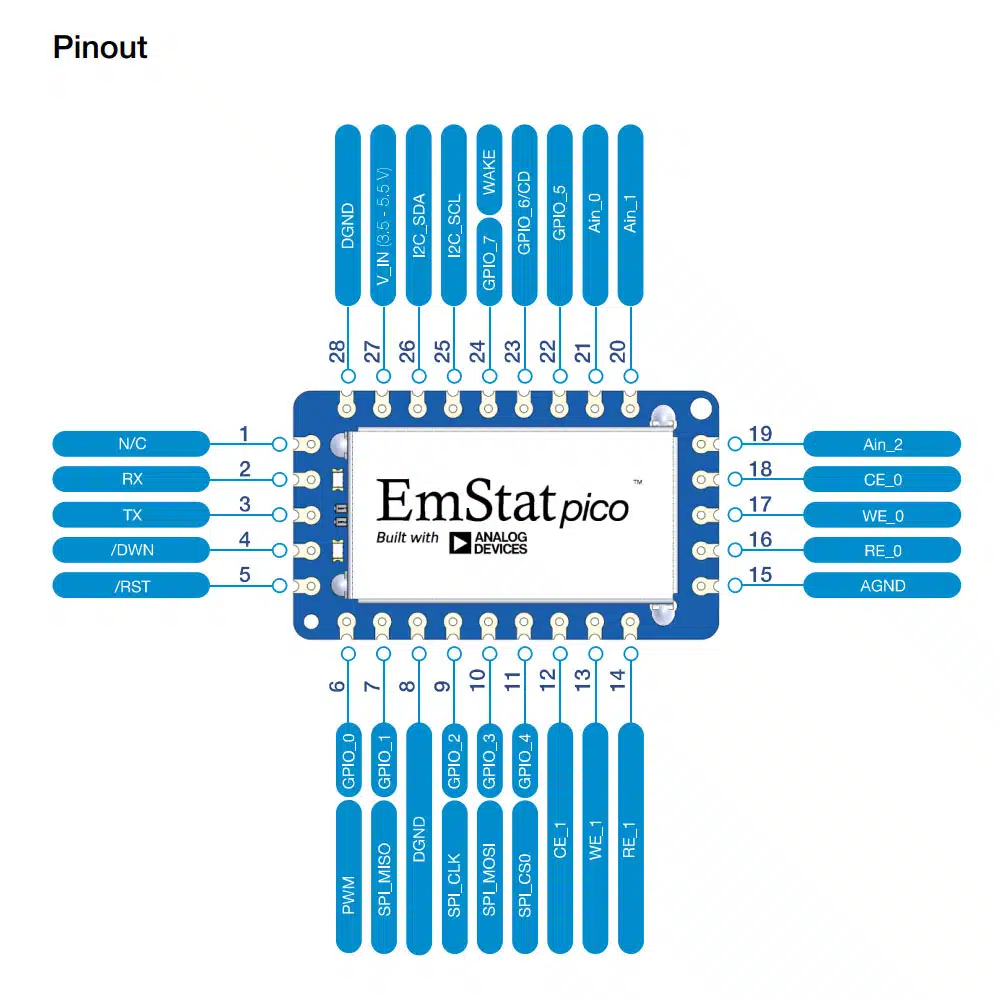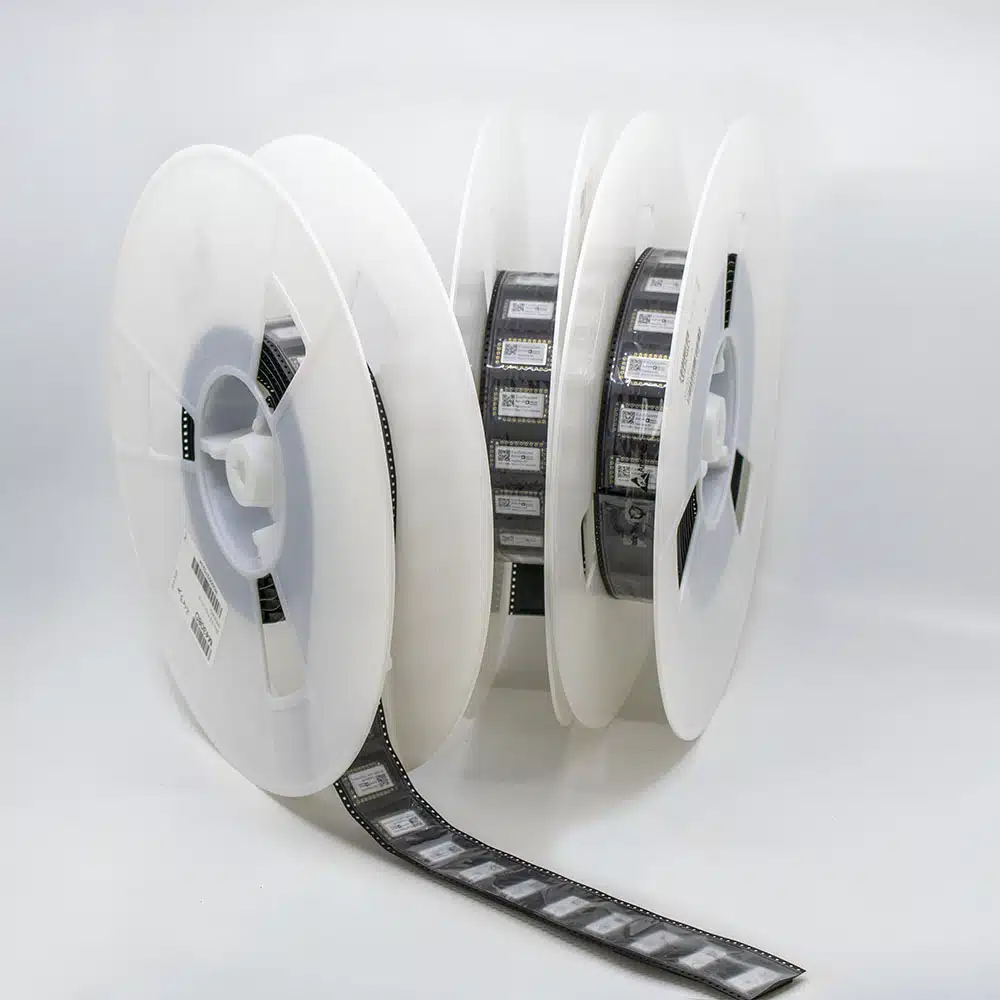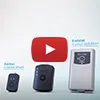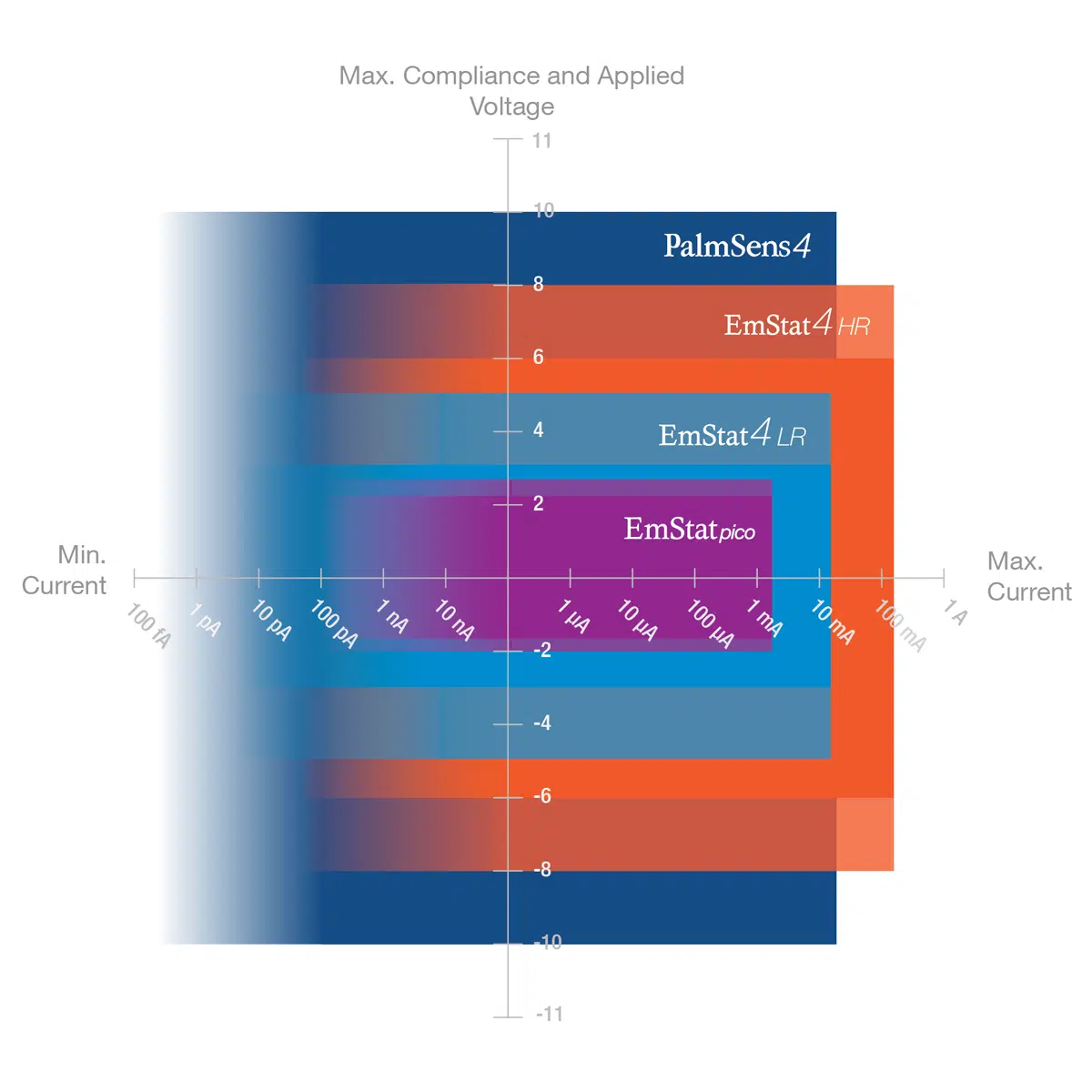EmStat Pico Module
Proven, tested and calibrated dual-channel potentiostat
- Enables rapid prototyping, no programming skills needed
- Easy to reproduce measurements using MethodSCRIPT
- Support from Analog Devices & PalmSens
- Used by 200+ OEM customers
Description
The EmStat Pico is a proven stand-alone potentiostat module which enables you to perform electrochemical measurements using your own electrochemical sensor without programming skills. You can integrate this small dual-channel module on your PCB without any potentiostat knowledge thanks to the joint development by Analog Devices Inc and PalmSens. Our tested and calibrated modules are used by over 100+ OEM customers in over 30 countries. Our network, experience and support will help you succeed and save development time with the smallest potentiostat module on the market.
- Dimensions: 18 x 30 x 2.6 mm
- Dual channel (2x WE, 2x RE, 2x CE)
- EIS frequency range: 0.016 Hz to 200 kHz
- Full dc-potential range: -1.7 V to +2 V
- Current ranges: 100 nA to 5 mA
- Four different versions available, each with different electrochemical techniques.
Please contact us for both low-volume and high-volume quotes. The EmStat Pico module and EmStat Pico Development Kit are also available on Arrow and Digi-Key.
Specifications
The module works at three different modes;
Low Speed mode: for scan rates up to 1 V/s or a bandwidth of 100 Hz.
High Speed mode: for high scan rates and frequencies.
Max Range mode: a combination of the Low and High Speed modes for optimal dynamic dc-potential range.
| General | |||
|---|---|---|---|
| Low Speed mode | High Speed mode | Max Range mode | |
| Full dc-potential range
The maximum potential difference, that can be applied between WE and RE.
|
-1.2 to +2 V | -1.7 to +2 V | -1.7 to +2 V |
| Dynamic dc-potential range [1]
The maximum potential difference, that can be applied between WE and RE.
|
2.2 V | 1.2 V | 2.6 V |
| Compliance voltage | -2.0 to +2.3 V [2] | ||
| Maximum current | ± 3 mA | ||
| Max. data acquisition rate (datapoints/s) | 100 | 1000 | 100 |
| Supports FRA/EIS | NO | YES | NO |
| [1] The dynamic range is the range that can be covered during a single scan within the full potential range. For example; a linear scan can start at -1.5 V and end at 1.1 V or vice versa, covering 2.6 V dynamic range. [2] The compliance voltage is the maximum potential between Working and Counter electrode and depends on the selected mode.
The compliance voltage is the maximum voltage that can be applied between the working and counter electrode. Another name could be the maximum cell potential. Continue reading
|
|||
| Dual-channel and Bipotentiostat functionality |
|---|
|
| Potentiostat (controlled potential mode) | |||
|---|---|---|---|
| Low Speed mode | High Speed mode | Max Range mode | |
| Channels | 2 (2x WE, 2x RE and 2x CE) | ||
| Applied dc-potential resolution | 537 µV | 395 µV | 932 µV |
| Applied potential accuracy | < 0.2% | < 0.5% | < 0.5% |
| Current ranges | 100 nA, 2 uA, 4 uA, 8 uA, 16 uA, 32 uA, 63 uA, 125 uA, 250 uA, 500 uA, 1 mA, 5 mA |
100 nA, 1 uA, 6 uA, 13 uA, 25 uA, 50 uA, 100 uA, 200 uA, 1 mA, 5 mA |
100 nA, 1 uA, 6 uA, 13 uA, 25 uA, 50 uA, 100 uA, 200 uA, 1 mA, 5 mA |
| Current accuracy | < 0.5 % of current ±0.1% of range | < 1 % of current ±0.1% of range | |
| Measured current resolution | 0.006% of selected current range (5.5 pA on 100 nA range) |
||
| Measured potential resolution (for OCP) | 56 uV | ||
| FRA / EIS (impedance measurements) | |
|---|---|
| Frequency range | 0.016 Hz to 200 kHz |
| Ac-amplitude range | 1 mV to 0.25 V rms, or 0.708 V p-p |
| Bipotentiostat | |
|---|---|
| Modes | 1. WE2 at fixed potential (E offset vs RE1) 2. WE2 scanning (E offset vs WE1) |
| Max. potential WE2 | ΔE(WE1) + ΔE(WE2) < 1.6 V [3] |
| [3] If your main WE1 is scanning from -0.5V to +0.5V, the WE2 can only have a maximum offset of 0.6V. |
|
| Electrometer | |
|---|---|
| Electrometer amplifier input | > 1 TΩ // 10 pF |
| Bandwidth | 250 kHz |
| Communications and peripherals | |
|---|---|
| Module communication | UART |
| Communication with external peripherals | SPI and I2C |
| Analog I/O | 3 analog input pins |
| Digital I/O | 7 general-purpose I/O pins 1 wake-up pin |
| On-board temperature sensor | ±2 °C or ±0.25 °C [4] |
| [4] The high accurate on-board temperature sensor is standard available on modules that come with the EmStat Pico Development Kit. For separate EmStat Pico modules the temperature sensor is optional. | |
| Other | |
|---|---|
| Storage | 4000 datapoints on-board (supports optional external SD card for mass storage) |
| Mounting | Surface mounted with castellated pads Through hole pins (2.54 mm pitch) |
| Dimensions | 30.5 mm X 18 mm X 2.6 mm |
| Operation temperature range | -40°C to +85°C |
| EIS Accuracy Contour Plot |
|---|
 |
Software Development
Develop software for PC, smartphone or microcontroller
Whether you want to write a simple or advanced Windows application, develop an Android or iPhone app or integrate the EmStat Pico in your own hardware, you can do it with our software development tools and code examples.
The EmStat Pico Development Board can also be controlled directly with our PSTrace software for Windows and PStouch app for Android.

Software Development Kits for .NET
The PalmSens Software Development Kits (SDKs) for .NET can be used with any of our instruments or OEM potentiostat modules to develop your own software. The SDK’s come with a set of examples that shows how to use the libraries.
PalmSens SDKs with examples are available for the following .NET Frameworks:
- WinForms
- WPF
- Xamarin (for Android)
- UWP
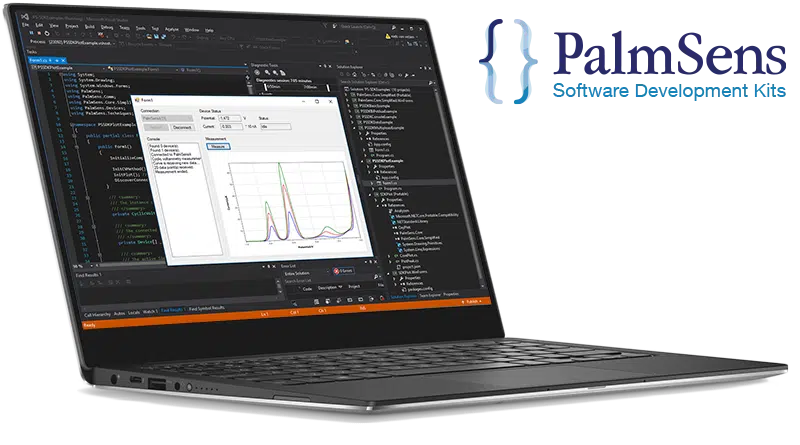
MethodSCRIPT™ communications protocol
The EmStat Pico potentiostat module has an on-board parser for the MethodSCRIPT™ scripting language. This language allows developers to program a human-readable script for the EmStat Pico module on any platform or operating system. The simple script language allows for running electrochemical techniques supported by EmStat Pico and makes it easy to combine different measurements and other tasks.

Downloads
Application Note (5)
| Name | Last updated | |
|---|---|---|
| EmStat Pico firmware updating Shows how to update the firmware on an EmStat Pico module, or any of the Sensit Series instruments. | 08-07-24 | |
| Characterization of Field Effect Transistors Characterization of a Field-effect Transistor (FET) using an EmStat Pico potentiostat module. | 09-11-22 | |
| Vitamin C Detection with ItalSens IS-C This application note describes how to create a calibration for quantitative measurements of vitamin C. Due to the detailed description and harmless solutions this an excellent electrochemical experiment with liquids for beginners in the field of electrochemistry. | 27-01-21 | |
| Limitations for EIS on EmStat Pico | 18-12-20 | |
| pH Measurement using EmStat Pico This article shows the ease of integration of the device into a system and demonstrates the range of applications of the potentiostat module by detailing three different electrochemical measurements: OCP (pH), cyclic voltammetry, and EIS. | 07-09-20 |
Software (8)
| Name | Last updated | |
|---|---|---|
| PSTrace PC software for all single channel instruments PSTrace software is shipped as standard with all single channel and multiplexed instruments. The software provides support for all techniques and device functionalities. | 08-07-24 | |
|
MethodSCRIPT code examples
MethodSCRIPT code examples include:
- MethodSCRIPTExample_C - MethodSCRIPTExample_C_Linux - MethodSCRIPTExample_C# - MethodSCRIPTExample_Arduino - MethodSCRIPTExample_Python - MethodSCRIPTExample_iOS - MethodSCRIPTExample_Android Every code example comes with a "Getting Started" document. |
07-07-24 | |
| PalmSens SDK for Python PalmSens Python SDK 5.9 with support for PalmSens instruments. | 07-11-22 | |
| EmStat Pico Firmware v1.3.4 See app note "EmStat Pico firmware updating" for more information about updating built-in and bare EmStat Pico modules. | 13-12-21 | |
| EmStat Pico Firmware v1.2 See app note "EmStat Pico firmware updating" for more information about updating built-in and bare EmStat Pico modules. | 13-12-21 | |
| Getting started with PalmSens SDK for WPF This manual explains how to use the SDK with the included libraries and examples. | 07-06-21 | |
| Getting started with PalmSens SDK for WinForms This manual explains how to use the SDK with the included libraries and examples. | 07-06-21 | |
| Getting started with PalmSens SDK for Android This manual explains how to use the SDK with the included libraries and examples. | 07-06-21 |
Documentation (13)
| Name | Last updated | |
|---|---|---|
| MethodSCRIPT v1.5 The MethodSCRIPT scripting language is designed to improve the flexibility of the PalmSens potentiostat and galvanostat devices for OEM users. It allows users to start measurements with arguments that are similar to the arguments in PSTrace. PalmSens provides libraries and examples for handling low level communication and generating scripts for MethodSCRIPT devices such as the EmStat Pico and EmStat4. | 25-03-24 | |
| Entering the Bootloader This document explains how to enter the bootloader of the EmStat Pico or the EmStat4M and update the firmware. | 05-10-23 | |
| MethodSCRIPT v1.4 The MethodSCRIPT scripting language is designed to improve the flexibility of the PalmSens potentiostat and galvanostat devices for OEM users. It allows users to start measurements with arguments that are similar to the arguments in PSTrace. PalmSens provides libraries and examples for handling low level communication and generating scripts for MethodSCRIPT devices such as the EmStat Pico and EmStat4. | 01-02-23 | |
| EmStat Pico Brochure Brochure of the EmStat Pico module and software tools | 12-09-22 | |
| EmStat Pico communication protocol v1.3 This document describes the “online” communication protocol of the EmStat Pico. Initial communication with an EmStat Pico is always done using this online communication. Measurements and other scripts can be started by sending a MethodSCRIPT, | 13-06-22 | |
| MethodSCRIPT v1.3 The MethodSCRIPT scripting language is designed to improve the flexibility of the PalmSens potentiostat and galvanostat devices for OEM users. It allows users to start measurements with arguments that are similar to the arguments in PSTrace. PalmSens provides libraries and examples for handling low level communication and generating scripts for MethodSCRIPT devices such as the EmStat Pico and EmStat4. | 19-01-22 | |
| EmStat Pico RoHS statement | 28-07-21 | |
| EmStat Pico Reliability Report This report describes the tests performed on the EmStat Pico to confirm the reliability and evaluate the accelerated lifetime. | 26-07-21 | |
| MethodSCRIPT v1.2 MethodSCRIPT v1.2 protocol description | 28-04-20 | |
| MethodSCRIPT v1.1 MethodSCRIPT v1.1 protocol description | 17-04-20 | |
| EmStat Pico example test report EmStat Pico example test report | 08-04-20 | |
| EmStat Pico communication protocol v1.2 Describes the EmStat Pico communications protocol which is based on MethodSCRIPT | 08-04-20 | |
| EmStat Pico communication protocol v1.1 Describes the EmStat Pico communications protocol which is based on MethodSCRIPT | 28-08-19 |
Datasheet (1)
| Name | Last updated | |
|---|---|---|
| EmStat Pico Datasheet Contains the information you need for integration of the EmStat Pico in your electronics design. | 05-07-23 |
Other (3)
| Name | Last updated | |
|---|---|---|
| Introduction to electrochemical sensing – Tutorial The first part of this presentation contains how electrochemistry works and how it can be used for sensing applications. The second half explains what a potentiostat is and which applications are suitable for the EmStat Pico potentiostat offered by PalmSens. Details of the EmStat Pico’s capabilities will be shown, as well as instructions on how to use it. | 15-07-21 | |
| EmStat Pico footprint for Altium EmStat Pico footprint for use with Altium PCB Designer | 14-05-20 | |
| EmStat Pico 3D model 3D STEP file of the EmStat Pico module | 08-02-20 |

















